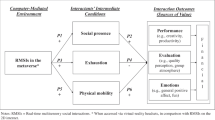Abstract
Advances in artificial intelligence and computer graphics digital technologies have contributed to a relative increase in realism in virtual characters. Preserving virtual characters’ communicative realism, in particular, joined the ranks of the improvements in natural language technology, and animation algorithms. This paper focuses on culturally relevant paralinguistic cues in nonverbal communication. We model the effects of an English-speaking digital character with different accents on human interactants (i.e., users). Our cultural influence model proposes that paralinguistic realism, in the form of accented speech, is effective in promoting culturally congruent cognition only when it is self-relevant to users. For example, a Chinese or Middle Eastern English accent may be perceived as foreign to individuals who do not share the same ethnic cultural background with members of those cultures. However, for individuals who are familiar and affiliate with those cultures (i.e., in-group members who are bicultural), accent not only serves as a motif of shared social identity, it also primes them to adopt culturally appropriate interpretive frames that influence their decision making.



Similar content being viewed by others
Notes
This approach represents a significant contribution to the field of communication science. Communication scholars in the area of psycho-social-linguistics typically use Lambert’s (1967) matched guise paradigm. In this paradigm, the same speaker (a bicultural research confederate) displays at least two accents and researchers study the effect on listeners. Our method utilizing advanced AI, natural language, and animation technology overcomes traditional problems with the matched-guise technique because it uses a visually identical speaker, hence matched-guise, while being able to use two different voices. The problem with Lambert’s original matched guise paradigm, which is still prevalent (Fuertes et al. 2012), is that the same person speaks different variations of an accent. While it is plausible that bi-lingual people can adeptly speak both native and accented English, there is likely a slight difference between the different accents, e.g., one accent might have a slight accent infused from the other language. There are also potential confounds that could arise, due to the person speaking in both accents, because other behaviors congruent with that culture, such as gesture, might get inadvertently primed. Virtual characters allow us to use different real people speaking English in various accents, while still keeping the character’s visual appearances and non-verbal behaviors identical.
Praat, http://www.fon.hum.uva.nl/praat/.
OKAO Technology, http://www.omron.com/r_d/coretech/vision/okao.html.
References
Alelo Inc. (2012) Retrieved December 12, 2012, from www.alelo.com
Andre AD, Wickens CD (1995) When users want what’s NOT best for them. Ergon Des 3(4):10–14
Benet-Martinez V, Leu J, Lee F, Morris MW (2002) Negotiating biculturalism: cultural frame switching in biculturals with oppositional versus compatible cultural identities. J Cross Cult Psychol 33(5):492–516. doi:10.1177/0022022102033005005
Blascovich J (2002) A theoretical model of social influence for increasing the utility of collaborative virtual environments. ACM Press, New york, pp 25–30. doi:10.1145/571878.571883
Blascovich J (2013) Challenge, threat and social influence in digital immersive virtual environments. In: Gratch J, Marsella S (eds) Social emotions in nature and artifact: emotions in human and human-computer interaction. Oxford University Press, Oxford
Blascovich J, McCall C (2013) Social influence in virtual environments. In: Dill K (ed) Oxford handbook of media psychology. Oxford University Press, Oxford, pp 305–315
Brewer MB (1991) The social self: on being the same and different at the same time. Pers Soc Psychol Bull 17(5):475–482. doi:10.1177/0146167291175001
Chattaraman V, Lennon SJ, Rudd NA (2010) Social identity salience: effects on identity-based brand choices of Hispanic consumers. Psychol Market 27(3):263–284. doi:10.1002/mar.20331
Chen SX, Bond MH (2007) Explaining language priming effects: further evidence for ethnic affirmation among Chinese-English Bilinguals. J Lang Soc Psychol 26(4):398–406. doi:10.1177/0261927X07306984
D’Andrade RG (1984) Cultural meaning systems. In: Schweder RA, Levine RA (eds) Culture theory. Essays on mind, self and emotion. Cambridge University Press, Cambridge, pp 88–119
Dahlbäck N, Wang Q, Nass C, Alwin J (2007) Similarity is more important than expertise. ACM Press, New york, p 1553. doi:10.1145/1240624.1240859
Friedman RA, Liu W, Chi S-C, Hong Y (2006) Western exposure: the effects of foreign experience on Taiwanese Managers’ cognition. SSRN Electron J. doi:10.2139/ssrn.935134
Fuertes JN, Gottdiener WH, Martin H, Gilbert TC, Giles H (2012) A meta-analysis of the effects of speakers’ accents on interpersonal evaluations. Eur J Soc Psychol 42(1):120–133. doi:10.1002/ejsp.862
Huang L, Morency LP, Gratch, J (2011) Virtual Rapport 2.0. In: International conference on intelligent virtual agents, pp 68–79
Haidt J, Koller S, Dias M (1993) Affect, culture, and morality, or is it wrong to eat your dog? J Pers Soc Psychol 65:613–628
Hartholt A, Gratch J, Weiss L, Team TG (2009) At the virtual frontier: Introducing gunslinger, a multi-character, mixed-reality, story-driven experience. In: Ruttkay Z, Kipp M, Nijholt A, Vilhjálmsson H (eds) Intelligent virtual agents, lecture notes in computer science. Springer, Berlin, pp 500–501
Henrich J, Heine SJ, Norenzayan A (2010) The weirdest people in the world? Behav Brain Sci 33:61–135
Hong Y, Morris MW, Chiu C, Benet-Martínez V (2000) Multicultural minds: a dynamic constructivist approach to culture and cognition. Am Psychol 55(7):709–720. doi:10.1037/0003-066X.55.7.709
Jancsary J, Neubarth F, Trost H (2011) First workshop on algorithms and resources for modelling of dialects and language varieties. Presented at the Dialects 2011, Association for Computational Linguistics, Edinburgh, Scotland
Kopp S, Krenn B, Marsella S, Marshall AN, Pelachaud C, Pirker H, Vilhjálmsson H (2006) Towards a common framework for multimodal generation: the behavior markup language. In: International conference on intelligent virtual agents, pp 21–23
Lambert WE (1967) A social psychology of bilingualism. J Soc Issues 23:91–109
Lombard M, Ditton T (1997) At the heart of it all: the concept of presence. J Comput Mediat Commun 3(2). doi:10.1111/j.1083-6101.1997.tb00072.x
Loomis JM, Blascovich JJ, Beall AC (1999) Immersive virtual environments as a basic research tool in psychology. Behav Res Methods Instrum Comput 31(4):557–564
Medin D, Bennis W, Chandler M (2010) Culture and the home-field disadvantage. Perspect Psychol Sci 5(6):708–713. doi:10.1177/1745691610388772
Nass CI, Brave S (2007) Wired for speech: how voice activates and advances the human-computer relationship. MIT Press, Cambridge
Nass CI, Yen C (2010) The man who lied to his laptop: what machines teach us about human relationships. Current, New York
Rader E, Echelbarger M, Cassell, J (2011) Brick by brick. In: Proceedings of the 2011 annual conference on human factors in computing systems–CHI’11, Vancouver, BC, Canada, p 2971. doi:10.1145/1978942.1979382
Reeves B, Nass C (1996) The media equation: how people treat computers, television, and new media like real people and places. Cambridge University Press, New York
Shweder RA, Much NC, Mahapatra M, Park L (1997) The “Big Three” of Morality (Autonomy, Community, Divinity) and the “Big Three” Explanations of Suffering. In: Brandt A, Rozin P (eds) Morality and health. Routledge, New York, pp 119–169
Thiebaux M, Marsella S (2007) Smartbody: Behavior realization for embodied conversational agents. In: 7th International conference on intelligent virtual agents (IVA)
Yin L, Bickmore TW, Cortes DE (2010) The impact of linguistic and cultural congruity on persuasion by conversational agents. In: Proceedings of IVA, Lecture notes in computer science. Presented at the intelligent virtual agents, Springer, Philadelphia, PA, pp 343–349. Retrieved from http://relationalagents.com/publications/IVA10.culture.pdf
Acknowledgments
The authors would like to thank Jim Blascovich and Ari Shapiro for comments on drafts of this manuscript. A postdoctoral fellowship from the ARL HRED Cognitive Sciences Branch supported the first author.
Author information
Authors and Affiliations
Corresponding author
Rights and permissions
About this article
Cite this article
Khooshabeh, P., Dehghani, M., Nazarian, A. et al. The cultural influence model: when accented natural language spoken by virtual characters matters. AI & Soc 32, 9–16 (2017). https://doi.org/10.1007/s00146-014-0568-1
Received:
Accepted:
Published:
Issue Date:
DOI: https://doi.org/10.1007/s00146-014-0568-1




